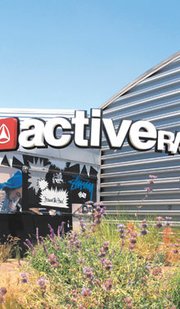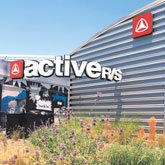Skate Chain on the Comeback Trail
Almost one year after high-profile skate chain Active Ride Shop declared bankruptcy, a new ownership is finding out whether it can recapture the mojo that made the Mira Loma, Calif.–based company one of the stars of skate-fashion retailing.
“We are not making any drastic changes,” promised Esmail Mawjee, who has served as president of the 21-store chain spread throughout Southern California since July. “We are strategizing what our next step will be.”
For more than five years, Active was the must-be-seen place for many surf, skate and fashion vendors. In 2008, the rapidly expanding skate chain was named men’s retailer of the year by the Surf Industry Manufacturers Association for having the best mix of men’s merchandise. Sales in 2008 totaled $61.8 million with a net loss of $2 million. By 2009, sales dipped to $59.9 million, but net loss mushroomed to $7.7 million.
That forced Active, started in 1989, to file for Chapter 11 bankruptcy protection on March 23, 2009, in U.S. Bankruptcy Court in Riverside, Calif. At the time, Active owed secured creditors $4.7 million and unsecured creditors $15.2 million.
In the bankruptcy petition, the chain’s founders, The Active Wallace Group, blamed the losses on bad timing. The company went on a store-opening spree at a time when the economy started to sour. At its height, the company had a roster of 30 stores. “The debtor’s total sales have stayed approximately the same over the last few years, while the number of stores has approximately doubled during the same period,” the petition said.
Following its bankruptcy filing, the company was up for sale. Well-known Active competitors Zumiez and Surf Associates Inc. (BC Surf & Sport) bid for the retailer, but the auction winner was Florida-based Active Sports Lifestyle USA, LLC. The little-known company outbid the others with an offer to pay $4.2 million in secured debt to Merrill Lynch and $1 million to settle other matters relating to the bankruptcy. However, the retailer’s unsecured debtors—which included such high-profile fashion names as Ezekiel, Quiksilver, Vans and Element—never received the money they were owed.
Active Sports Lifestyle is owned by Issa Ladha, who ran a fashion wholesale company in the 1970s and, until 1985, owned a Miami-based fashion store called Rani’s Boutique Inc. Mawjee was the president of the store, which sold sportswear for men, women and children. In 1985, Rani’s Boutique was sold. It is still in business.
Ladha went on to focus on commercial real estate and hotels while Mawjee ran an education company in Toronto. But the two recently reunited to take up retailing again because Active looked like a great bet. “We’re entrepreneurs,” Mawjee said. “We invest in whatever excites us. Active excited us a lot. It’s a company that has a huge potential.”
Mawjee will run Active’s day-to-day business and work on strengthening the retailer. “There will be no closing or openings [of stores] for a year or two. We want to make sure we can manage what we have in a responsible way,” Mawjee said, noting the small chain is slightly profitable since his team took over. But he declined to predict what Active’s revenues will be this year.
Since it took control of the retailer, Active’s new management has embarked on a campaign to repair the company’s relationships with its past vendors. “It’s a touchy subject with vendors,” Mawjee said. “We will adhere to requirements of paying on time and being disciplined on financial dealings.”
Even though some labels never got paid by the previous owners, the overwhelming majority of Active’s previous vendors continue to do business with the new store. Frank Kaufman, a partner in accounting firm Moss Adams LLP and a consultant to many Orange County surf and skate manufacturers, said Active was too prominent to fail. “No one wants to lose a retailer, even though a lot of people got hurt,” he noted.
At first, vendors took a wait-and-see-approach, said Frank Delgadillo, founder of Costa Mesa, Calif.–brand Comune, which has sold its merchandise to Active under the old and new owners. “There was caution until we got to know who was behind the finances of Active,” said Delgadillo, who is on friendly terms with Active’s new management as well as the old owners, the Wallace family.
Apparel companies developed more faith in Active when Mawjee brought in a new accounting team, but he kept the creative and marketing staff that made Active so popular among fashion-savvy skateboarders and their friends. Still on board are Jason Dean, vice president of sales and operations; Bobby Goodwin, merchandising director; Danny Blanton, creative director; and Brent Futagaki, marketing director. These executives have been working at Active more than 10 years.
Mawjee promised his team would strengthen their partnership with their vendors by increasing the floor space devoted to popular skate brands such as Obey, Vans, RVCA and Nike SB. There will be less emphasis on the chain’s burgeoning private-label Active, said Dean, the vice president of sales and operations. “A majority of our business will be branded goods,” he said. “Our goal is not to be a vertical retailer. Our goal is to show the right brands and let Active be the right place to showcase brands.”
Perhaps more proof of Active’s future as a multi-line retailer will be seen in the new management’s first marketing initiative. On June 3, it will debut The Workshop, a 20-by-10-foot space at the flagship store in Santa Monica, Calif. The prominent space will call attention to its vendors’ socially conscious projects and display lines, such as Obey’s Awareness Collection, that are specifically manufactured to raise money for nonprofits. Proceeds from The Workshop will go toward the various nonprofits supported by the apparel lines.
After The Workshop’s success is evaluated, it most likely will be rolled out in other Active stores. “This initiative is woven into the fabric of Active,” Mawjee said. “It is part of our DNA. We are part of the community as a whole. We will be engaged.”

























